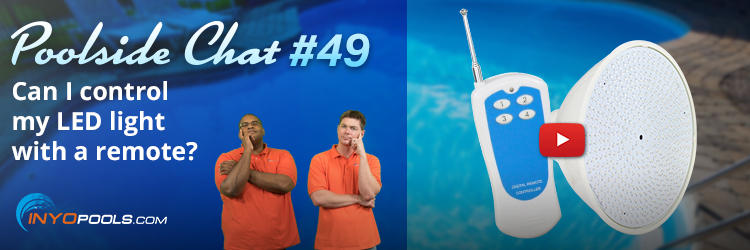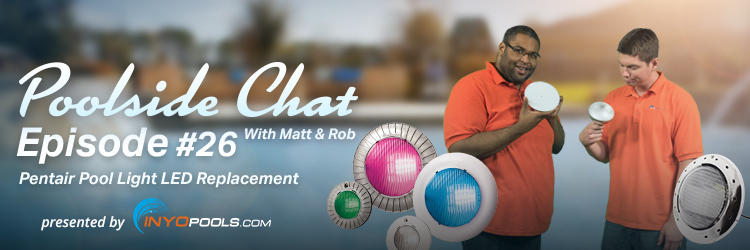
Pool Light
Troubleshooting
Resources for fixing your light problems.

Tip: Keeping your pool lights well-maintained enhances nighttime visibility and adds a beautiful ambiance to your pool area. Regularly check the light fixtures for any signs of damage, ensure that seals are intact to prevent water leakage, and clean off any dirt or algae buildup from the lenses for optimal brightness. For LED lights, consider upgrading to energy-efficient models that last longer and reduce energy costs. Properly maintained pool lights provide safe and enjoyable swimming after dark while enhancing your pool’s aesthetics.
Common Light Problems
Click on a symptom that you are experiencing…
Light Won’t Turn On
Problem:
If your pool light isn’t turning on, it could be due to several factors, including a blown bulb, faulty wiring, or issues with the power supply. Diagnosing the problem promptly is essential for both safety and maintaining the ambiance of your pool area.
Action Items:
- Check the bulb: Inspect the light bulb for signs of damage or burning out. Replace the bulb with a compatible type if necessary.
- Test the power supply: Verify that the circuit breaker is not tripped and that the GFCI outlet is functioning properly. Reset the breaker or replace the fuse if needed.
- Inspect wiring connections: Examine the wiring leading to the light fixture for any visible damage or loose connections. Tighten or repair any damaged wires as needed.
- Use a multimeter: If you have electrical experience, use a multimeter to test for voltage at the light fixture. This can help determine if the issue lies within the fixture or upstream in the power supply.
Light Flickers or Shuts Off Intermittently
Problem:
If your pool light is flickering or shutting off intermittently, it may indicate loose connections, a failing bulb, or issues with the power source. Addressing this promptly can prevent further damage and improve safety around the pool.
Action Items:
- Check for loose connections: Inspect the wiring connections at both the power source and junction boxes. Tighten any loose connections to ensure a stable power supply.
- Replace the bulb: A flickering light can be a sign of a bulb nearing the end of its life. Try replacing the bulb with a new, compatible one to see if the issue resolves.
- Inspect the power source and GFCI: Make sure the GFCI outlet and circuit breaker aren’t tripping. If they are, there may be a grounding issue or water seepage affecting the fixture.
- Check for water intrusion: Water inside the light fixture can cause flickering. If you notice moisture, have the fixture inspected and sealed by a professional to prevent further damage.
Light is Dim or Only Partially Illuminated
Problem:
A dim or partially illuminated pool light may be due to a low-quality bulb, loose connections, or buildup on the lens. This can make your pool area feel less inviting and may indicate a need for maintenance or replacement parts.
Action Items:
- Clean the lens: Algae or calcium buildup on the light’s lens can reduce brightness. Clean the lens carefully to restore maximum light output.
- Check voltage and connections: Ensure that the fixture is receiving the correct voltage and that all connections are secure. Loose or partially connected wires can reduce power to the bulb, leading to dimming.
- Replace with a high-quality bulb: Sometimes, dimness can be resolved by upgrading to a higher-quality or higher-lumen bulb compatible with your fixture.
- Inspect for water intrusion: Water inside the light fixture can cause the light to appear dim. If you see moisture, have the fixture dried, sealed, and checked for damage to prevent further issues.
Water Inside Light Fixture
Problem:
Water inside a pool light fixture is usually caused by a worn-out seal or gasket, allowing moisture to enter. This issue can lead to flickering, short-circuiting, or even electrical hazards, so addressing it promptly is essential.
Action Items:
- Turn off the power: For safety, switch off the power at the circuit breaker before inspecting or handling the fixture.
- Inspect and replace the gasket: A damaged or aging gasket is often the source of leaks. Remove the fixture and inspect the gasket for cracks or wear. Replace it with a new, compatible gasket to ensure a watertight seal.
- Dry the fixture: Open the fixture and allow it to fully dry out. You can use a soft cloth or compressed air to remove moisture before resealing.
- Reinstall and test: After replacing the gasket and ensuring the fixture is dry, reinstall the light and turn the power back on to confirm that the leak has been resolved.
Light Overheats or Burns Out Quickly
Problem:
If your pool light is overheating or burning out faster than expected, it may be due to an incorrect bulb type or water inside the fixture causing damage. Overheating can shorten the bulb’s lifespan and potentially damage the fixture.
Action Items:
- Use the correct bulb: Ensure the bulb wattage matches the fixture’s specifications. A bulb that’s too powerful for the fixture can overheat, so always check compatibility.
- Inspect the fixture for water leaks: Water inside the fixture can cause bulbs to overheat and fail prematurely. Check the gasket and seal for leaks, and replace them as needed to keep the fixture dry.
- Reduce run time: If the light is used for extended periods, consider reducing its daily run time to prevent excess heat buildup.










